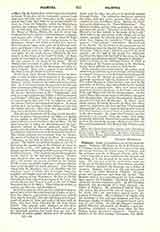

Palmyra, titular metropolitan see in Phoenicia Secunda. Solomon (III Kings, ix, 18) built Palmira (A. V. Tadmor) in the wilderness, but it is not certain that this means Palmyra, the Greek name of Tadmor, and the reference may be to Thamar (Ezech., xlvii, 19). For a long time it was a market for the Romans and Parthians, as it was situated on the route of the caravans. The city had a Greek constitution, made use of the era of the Seleucides, the Macedonian calendar, and a Semitic alphabet; the language was a dialect of Aramaic. Hadrian visited it in 129 and thenceforth the town was called Hadriana Palmyra. Its prosperity and monuments date from this period. The Romans used it as a starting-point for their expeditions against the Parthians. Septimius Severus and Alexander Severus sojourned there. In 258 Septimus Odaenath, the descendant of a local dynasty, was Prince of Palmyra. He proclaimed himself king in 260, and in 264 received the title of emperor. After his death (267) his inheritance passed under the regency of Zenobia. She established an empire with the assistance of her ministers Longinus and Paul of Samosata, Bishop of Antioch, conquered Egypt and a part of Asia Minor. In 272 the Emperor Aurelian sacked Palmyra and carried off Zenobia a prisoner. Diocletian established a camp there where the first Illyrian Legion afterwards sojourned. Justinian re stored it in the sixth century (Procopius, “De Aedificiis”, xi). In 745 it suffered from the wars of the Ommiads and Abbassids, in 1089 underwent an earthquake, and then fell completely into oblivion. The date of the introduction of Christianity into Palmyra is unknown. In 325 its bishop, Marinus, assisted at the Council of Nicae; another, John, signed at Chalcedon in 451 as suffragan of Damascus; another John was expelled as a Monophysite in 518 (Le Quien, “Oriens christ.”, II, 845). The diocese first depended on Tyre in Phoenicia, then on Damascus in Lebanon Phoenicia, as is shown by the Antioch “Notitia episcopatuum” of the sixth century (“Echos d’Orient”, X, 145; “Hieroclis Synecdemus”, ed. Burckhardt, 40); George of Cyprus, “Descriptio orbis romani”, ed. Gelzer, 50). After 761 Palmyra was a suffragan of Emesa (Echos d’Orient, X, 96). The ruins of Palmyra (now Toudmour) are among the most beautiful in the world.
S. VAILHÉ

